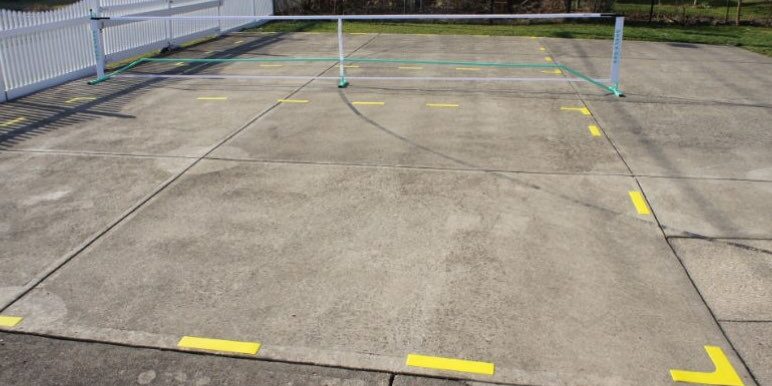Pickleball Court Construction-- Crucial Tips for a Long Lasting Court
Pickleball Court Construction-- Crucial Tips for a Long Lasting Court
Blog Article
Lasting Practices in Pickleball Court Building And Construction You Should Know
As the appeal of pickleball remains to climb, so as well does the need for sustainable techniques in court construction. This method not just addresses environmental worries but also enhances the durability and performance of the courts. From selecting green products to applying efficient drainage and energy-saving illumination services, there are various methods to consider. Yet, the influence of these techniques expands much past the court itself. Recognizing how each aspect adds to a more sustainable future welcomes even more expedition into the complex balance in between entertainment development and environmental stewardship.
Choosing Eco-Friendly Products
Choosing eco-friendly products is a crucial action in the building and construction of sustainable pickleball courts. The choice of lasting materials not only reduces ecological impact yet also boosts the durability and performance of the court. Secret products include reused rubber for the surface, which uses superb longevity and shock absorption while diverting waste from garbage dumps.
In addition, making use of in your area sourced materials minimizes transport exhausts and supports local economic climates. Pickleball court construction. For instance, using native woods for secure fencing and seats can give a lasting visual while ensuring strength against the aspects.
Integrating absorptive materials for court foundations can further add to sustainability by allowing for all-natural water drainage and lowering overflow. These selections not just safeguard neighborhood ecological communities yet likewise promote much healthier play atmospheres.
Efficient Water Drainage Solutions
While the choice of eco-friendly products is vital, implementing reliable drainage options is similarly essential for preserving lasting pickleball courts. Correct drainage not only secures the court surface area from water damage but additionally reduces erosion and overflow, promoting environmental stability.
Efficient water drainage systems can consist of permeable paving, which enables water to penetrate the ground as opposed to pooling on the surface area. This lowers the likelihood of standing water, which can result in mold and mildew and various other upkeep problems. In addition, including purposefully positioned drainage networks and swales can route excess water far from the court location, making sure a completely dry playing surface area and preventing soil erosion.
Making use of indigenous plants in the landscaping around the courts can even more enhance drainage by absorbing excess water and lowering drainage. These plants need less watering and advertise biodiversity, lining up with sustainable techniques.
In addition, it is vital to frequently preserve the water drainage system to ensure its long-term efficiency. This includes clearing up debris and monitoring for obstructions. By prioritizing reliable drain solutions, pickleball court erectors can considerably add to the sustainability and durability of the center, inevitably benefiting both gamers and the setting.
Energy-Efficient Lighting Options
As the demand for pickleball proceeds to grow, incorporating energy-efficient lights options into court style has actually come to be increasingly essential for sustainability. Typical lights systems typically eat too much power, adding to greater operational costs and environmental impact. Adopting modern, energy-efficient modern technologies is important for both brand-new constructions and renovations.
LED (Light Emitting Diode) lights attracts attention as a leading option due to its longevity and power cost savings (Pickleball court construction). Compared to standard illumination, LEDs use approximately 75% much less energy and can last up to 25 times much longer, considerably decreasing upkeep prices. Moreover, the directional nature of LED lighting decreases light contamination, guaranteeing that lighting is concentrated on the court as opposed to bordering areas.

Sustainable Surface Area Alternatives
Exploring sustainable surface area alternatives for pickleball courts has actually gained traction among building contractors and players alike. The emphasis on environment-friendly materials not only lines up with the expanding ecological recognition but additionally boosts the performance and sturdiness of the see courts.
This material gives superb shock absorption, minimizing the threat of injuries for players while promoting sustainability. These floor tiles are easy to install and replace, and their flexibility permits for various court configurations.
Natural yard courts are likewise becoming a sustainable choice, advertising biodiversity and decreasing the warm island result. However, they need routine upkeep and water, which might not align with all sustainability goals.

Water Conservation Strategies

An additional effective strategy includes the setup of rain harvesting systems. These systems save and gather rainwater for usage in maintaining court surface areas and landscaping. This approach not just saves safe and clean water however likewise minimizes reliance on municipal resources.
Furthermore, employing drought-resistant landscape design around the courts is vital. Native plants need less water and are much better adapted to neighborhood climate conditions, hence decreasing total water usage. Furthermore, utilizing reliable irrigation systems, such Source as drip watering, guarantees that water is supplied straight to plant roots, minimizing evaporation and waste.
Conclusion
Integrating sustainable methods in pickleball court construction dramatically adds to ecological conservation and source efficiency. By prioritizing these methods, the building and construction of pickleball courts can align with wider ecological have a peek here objectives while advertising long life and functionality within communities.
As the popularity of pickleball continues to increase, so also does the need for sustainable techniques in court building and construction.Picking environmentally friendly materials is a crucial step in the building of sustainable pickleball courts. By prioritizing energy-efficient illumination alternatives, pickleball court contractors can contribute to a more sustainable future while fulfilling the demands of gamers and stakeholders alike.Integrating sustainable surface area choices not just improves the performance of pickleball courts but additionally leads the method for executing effective water preservation techniques.Including sustainable practices in pickleball court construction dramatically contributes to environmental conservation and resource performance.
Report this page